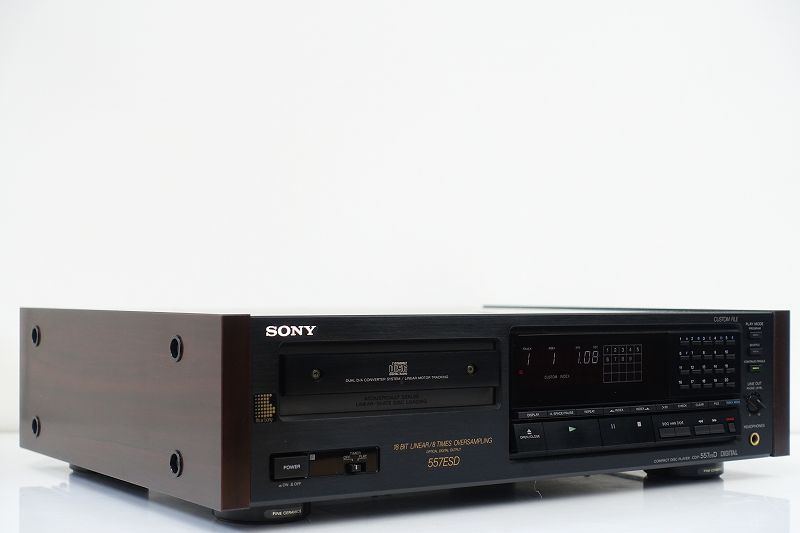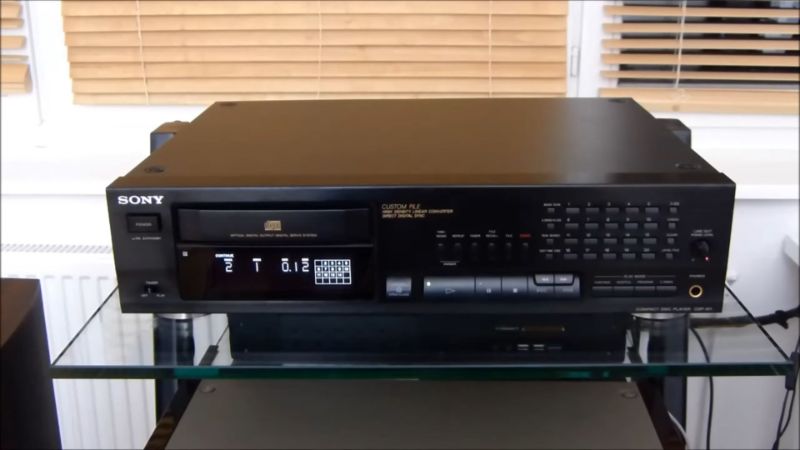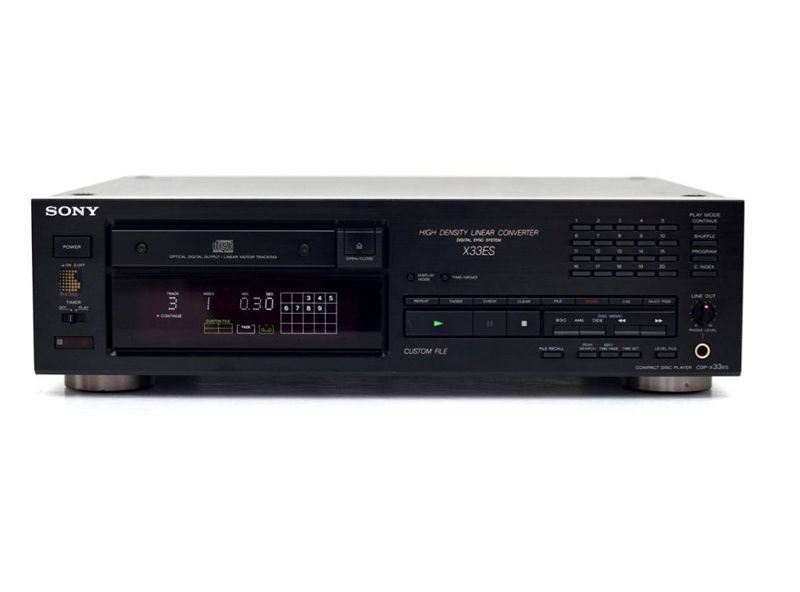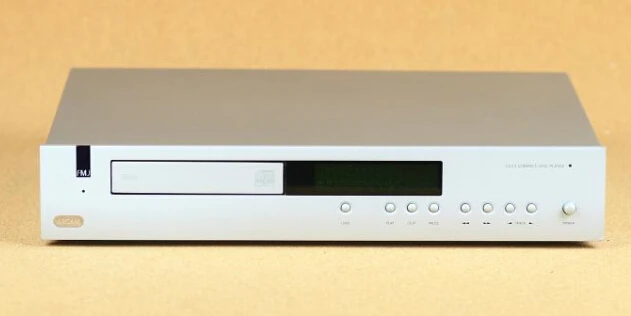Closing up the 1980s, Philips announced four new CD players, ranging in price from £149 for the entry-level model CD380 to about £500 for the flagship model Philips CD880.
Made in Belgium, the Philips CD880 is built on a heavy die-cast frame with a thick steel baseplate on trendy ‘drum’ feet, a copper-plated steel rear panel, and an extruded black anodized aluminium control panel, unlike the majority of Philips audio products, which rely heavily on the extensive use of plastics materials in their construction.
It reverts to the original CDM1 metal-based mechanism, now in Mark II form, and as a result, the entire machine has taken on a sense of substance and quality, with the thin undamped sheet-steel top cover being the main flaw. Despite this, it weights more than 10kg, more than three times the weight of standard Philips devices. When the disc is turned on, two rather pointless illuminated turquoise bars appear, as does the large and thoroughly comprehensive fluorescent display panel, which clearly indicates everything one could want to know about the contents of the chosen disc and illustrates any decision one might want to make about the way it is to be played.
Music Scan, Random order programming (of tracks, indexes, or time points up to 20), A to B repeat, Shuffle, Disc repeat, Copy pause, Skip, and Twospeed search up or down are among the other oriental touches. FTS (favorite track selection), a novel Philips function, allows the user to commit his or her favorite tracks from 135 discs at 675 points to the machine’s non-volatile memory for automated identification and repeat at any time. I can’t think of anything useful, aside from pitch change, that the Philips CD880 won’t accomplish on the spur of the moment; evidently, a lot of lessons have been learned since the early Philips versions. The hand-held infrared remote control can also be used to do most of the above functions.
Although this is appropriately labelled, the colors and typeface are poorly chosen, so you’ll have to rely on memorizing the position of the buttons, all 31 of them, under anything except full room lighting— fortunately, their grouping and form help. Two of the most significant buttons are fairly isolated and easy to locate; these give an extra feature, volume control through remote control. The huge notchy steps offered by previous Philips machines with this excellent feature were degraded by their controls.
In this scenario, a new digital control circuit is used, which provides 64 Id B steps, each of which is summarized by a miniature bar graph on the luminous display. On the back panel, there are two sets of gold-plated output sockets for fixed and variable outputs, and it’s worth remembering that, with the volume set to maximum, the signal voltage at the variable sockets is nearly twice that of the fixed outputs—3-75 Volts against 1-95 Volts on my sample.
Fortunately, the non-volatile memory stores the volume setting as well, so when the system is turned on, the output level is automatically set to where you last left it. There are also switched digital outputs, both coaxial and optical, and other connections at the back enabling linking to Philips system remote controls. A two-meter fixed mains lead is included, as well as a rear panel fuse.
The Philips CD880 is laid out in a traditional manner on the inside, with the drawer loading mechanism on the left side in front of the single power transformer with three secondary windings providing independent supplies for the servo, digital, and analogue sections. A separate printed circuit board houses the rectifiers, capacitors, and regulating circuitry.
The disc tray mechanism is also an improvement over previous versions, with the loading drawer sliding smoothly and silently, but not quite as quietly as the Sony models’ quick silent glide; still, in playing settings, silence is complete unless you choose to place your ear close to the case.
I was startled to discover that the tray on such a new machine had no provision for the 3-inch single disc, necessitating the use of an adaptor, but since this capability is known to exist in their cheaper machines, perhaps my early sample was ahead of the curve. The Philips swinging arm laser assembly has been improved, and its operation has been sped up to compete with other companies’ one-second track access. I’ve never noticed any jumps, skips, read-out errors, or other data loss while using this system.
All of the control push buttons and indicator connections are on a printed circuit panel, but all of the major components are on a single big, double-sided circuitboard that takes up the whole right-hand side of the internal area. There is evidence of great attention in the selection of components, particularly around the TDA1541 digital-to-analogue convertor chip, and many Cerafine capacitors can be found here as well as on the digital volume circuit board. As with all recent Philips models, l6-bit 4-times oversampling is the order of the day, and they claim to have hand-picked both the digital filter and the DAC chip.
The machine’s keypad and remote control both use the usual 1 to 9 plus 0 telephone layout, but the luminous display uses a 5/4 calendar format; the keys include a one-second ‘dwell’ to allow transmission of a second number for double figure tracks up to 99. The remaining buttons are properly labelled and, when combined with the presented information, make this a simple machine to operate, and one quickly becomes acquainted with it.
Another interesting feature is the inclusion of a separate internal headphone amplifier with its own volume control on the front panel. The source impedance has been set at 150 Ohms by Philips, which is a wise option that maximizes performance and averages sound pressure levels when using headphones with impedance ranging from 30 to 600 Ohms, but a broader range can be used with some loss of power transfer.
Our Philips CD880 had been in constant use since its arrival; it was clear from the start that it set a very high standard in a completely unspectacular way, passing all of my usual test discs satisfactorily; a selection chosen to identify any obvious deficiencies or inaccuracies in reproduction quickly.
It was, in my view, the best-sounding Philips machine to date, and if one compares it to the chosen reference, it demonstrates an intriguing and little-understood phenomenon that I refer to as the A B A effect. Going from reference A to test machine B shows minimal difference, but returning to A after an interval reveals more. On this premise, I would argue that the Philips sound has a trace of veiling, even if it is simply from a very thin gauze. The lower midrange and bass also have a little fuzzy character that becomes less defined and compartmentalized.
Overall, the effect is one of a well-filled, slightly warmed response. This is nicely demonstrated on the recent quite beautiful recital album of Wagnerian operatic scenes recorded in EMI’s Abbey Road studio with Jessye Norman, Klaus Tennstedt, and the LPO. Overall, focus, separation, and sense of depth are nicely preserved, and it’s unlikely that someone without quick comparison would ever drop on to either of the areas I’ve questioned; If they did, they’d probably prefer the Philips.
Despite lacking some of the constructional firmness of the better Japanese machines, the Philips CD880 is not wanting in features or sound quality, and comes with a fiber optics coupling lead as well as a superior set of phono-to-phono leads for the more common connection.







